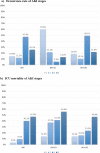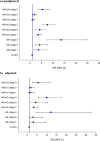Acute kidney injury in critical COVID-19: a multicenter cohort analysis in seven large hospitals in Belgium
- PMID: 35879765
- PMCID: PMC9310674
- DOI: 10.1186/s13054-022-04086-x
Acute kidney injury in critical COVID-19: a multicenter cohort analysis in seven large hospitals in Belgium
Abstract
Background: Acute kidney injury (AKI) has been reported as a frequent complication of critical COVID-19. We aimed to evaluate the occurrence of AKI and use of kidney replacement therapy (KRT) in critical COVID-19, to assess patient and kidney outcomes and risk factors for AKI and differences in outcome when the diagnosis of AKI is based on urine output (UO) or on serum creatinine (sCr).
Methods: Multicenter, retrospective cohort analysis of patients with critical COVID-19 in seven large hospitals in Belgium. AKI was defined according to KDIGO within 21 days after ICU admission. Multivariable logistic regression analysis was used to explore the risk factors for developing AKI and to assess the association between AKI and ICU mortality.
Results: Of 1286 patients, 85.1% had AKI, and KRT was used in 9.8%. Older age, obesity, a higher APACHE II score and use of mechanical ventilation at day 1 of ICU stay were associated with an increased risk for AKI. After multivariable adjustment, all AKI stages were associated with ICU mortality. AKI was based on sCr in 40.1% and UO in 81.5% of patients. All AKI stages based on sCr and AKI stage 3 based on UO were associated with ICU mortality. Persistent AKI was present in 88.6% and acute kidney disease (AKD) in 87.6%. Rapid reversal of AKI yielded a better prognosis compared to persistent AKI and AKD. Kidney recovery was observed in 47.4% of surviving AKI patients.
Conclusions: Over 80% of critically ill COVID-19 patients had AKI. This was driven by the high occurrence rate of AKI defined by UO criteria. All AKI stages were associated with mortality (NCT04997915).
Keywords: Acute kidney injury; COVID-19; Epidemiology; Intensive care unit; KDIGO; Kidney replacement therapy; Mortality; Renal replacement therapy; Serum creatinine; Urine output.
© 2022. The Author(s).
Conflict of interest statement
EH received Speakers fees from Alexion, Sopachem and Astute Medical paid to the institution and a travel grant from AM Pharma. All other authors declare no conflicts of interest.
Figures



References
-
- Panel C-TG. National Institute of Health; 2021. https://files.covid19treatmentguidelines.nih.gov/guidelines/covid19treat...
-
- COVID-19 Map [Internet]. Johns Hopkins Coronavirus Resource Center; 2021. https://coronavirus.jhu.edu/map.html
-
- Bayrakci N, Ozkan G, Sakaci M, Sedef S, Erdem I, Tuna N, et al. The incidence of acute kidney injury and its association with mortality in patients diagnosed with COVID-19 followed up in intensive care unit. Ther apheresis Dial Off Peer-Rev J Int Soc Apheresis Jpn Soc Apheresis Jpn Soc Dial Ther. 2022 doi: 10.1111/1744-9987.13790. - DOI - PubMed
Publication types
MeSH terms
Associated data
LinkOut - more resources
Full Text Sources
Medical
Research Materials

